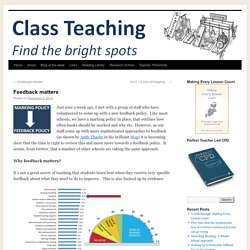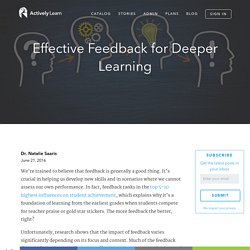

10-8-20 The Power of Feedback - John Hattie Webinar - Google Slides. 19. models critique and descriptive feedback excerpt copy. Developing Students' Ability to Give and Take Effective Feedback. Training kids to give effective critique is one of those teaching strategies that takes some time on the front end, but can save a lot of time once students get good at it. It’s common for students to give unhelpful, general or unkind feedback that doesn’t do much to advance a peer’s goals for the work, but Lukas found when she carefully trained students on some conversational “commandments” and attitudes around peer critique, 12-year-olds could give feedback as well as any adult.
Even better, when kids got feedback from peers, she found they internalized it more. But incorporating peer critique into the classroom does take time, which is most effectively spent on bigger, meatier projects that students are invested in improving. Why Giving Effective Feedback Is Trickier Than It Seems. A common feedback trap that Brookhart observes can happen when teachers forget the goal of an assignment and give feedback on things like grammar instead of the learning goal.

For example, if a seventh-grade science lab is meant to teach a concept, but all the feedback is about how the student formatted the lab, then the teacher has missed an opportunity. “Feedback then becomes what do I need to do to please this teacher, not what do I need to do to learn,” Brookhart said. She also points out that feedback depends entirely on the learning goals of individual students. One student may have trouble starting a problem, but generally understands the material, so simply reminding her of the learning target might be enough. Another student may have trouble starting because his grasp of the material is a little shaky, but some guiding questions might be enough to spark his thinking. “Tell the students what you see in their work,” Brookhart said.
Developing Students' Ability to Give and Take Effective Feedback. How Giving Students Feedback Through Video Instead of Text Can Foster Better Understanding. Narter is not alone. In the past few years, a handful of educators, working in different disciplines and various education levels, have made similar observations. Michael Phillips and Michael Henderson, education faculty at Monash University in Australia, have been experimenting with video feedback for years. They’ve created a website with recommendations for teachers who want to try it out themselves. To date, Phillips and Henderson have helped instructors use video feedback for classes from 20 to 700 students, across high schools and universities, in subjects as far ranging as philosophy and engineering.
Technology has limitations, of course. Overall, Phillips and Henderson, who previously taught in high schools, have been blown away by their pupils’ rave reviews. Cognitive scientists may be less surprised by the enthusiasm for video grading. Indeed, in the videos, teachers typically use a casual, conversational style, which students see as authentic and accessible. Feedback matters. Just over a week ago, I met with a group of staff who have volunteered to come up with a new feedback policy.

Like most schools, we have a marking policy in place, that outlines how often books should be marked and why etc. However, as our staff come up with more sophisticated approaches to feedback (as shown by Andy Tharby in his brilliant blog) it is becoming clear that the time is right to review this and move more towards a feedback policy. It seems, from twitter, that a number of other schools are taking the same approach. Documents - The Teachers Toolbox. Workshop 3 slides en. How To Give Students Specific Feedback That Actually Helps Them Learn.
How To Give Students Specific Feedback That Actually Helps Them Learn contributed by Justin Chando To tell a student ‘great job’ or ‘this needs work’ is a missed opportunity.

Everyone loves to hear they did a great job. And perhaps your student really did nail this latest assignment. But the problem with “great job” is this: it’s not specific. We were recently talking about this example among ourselves at Chalkup as we mulled over the future of feedback and assessment. We thought it might be interesting to take Wiggin’s list a step further and think through how to make these qualities actionable, asking ourselves what strategies look like for keeping feedback solid across the board. Changing Teachers’ Feedback Practices: A Workshop Challenge.
(148) LEARN087 Types and purposes of feedback. (148) Effective feedback animation. Feedback for Learning Infographic. “Most of the feedback that students receive about their classroom work is from other students – and much of that feedback is wrong.”

(John Hattie) The Association for Supervision and Curriculum Development (ASCD) is an international non-profit organization for teachers and educators. Its mission is “to develop programs, products, and services essential to the way educators learn, teach, and lead.” The Educational Leadership Magazine is ASCD’s flagship publication that is sent to its members eight times a year; subscriptions and individual issues are also available.
EL’s issue on “Feedback for learning” (Vol. 70/1) brings together renowned experts in this field: Grant Wiggins, John Hattie, Susan M. You can order your issue of Educational Leadership (Vol. 70/1) “Feedback for Learning” at shop.ascd.org. Feedback in schools by John Hattie. (148) Developing a Feedback Culture in Your Classroom. Seven Keys to Effective Feedback. 10 Feedback Techniques. Effective Feedback for Deeper Learning. Dr.

Natalie Saaris We’re trained to believe that feedback is generally a good thing. It’s crucial in helping us develop new skills and in scenarios where we cannot assess our own performance. In fact, feedback ranks in the top 5-10 highest influences on student achievement, which explains why it’s a foundation of learning from the earliest grades when students compete for teacher praise or gold star stickers. The more feedback the better, right? Unfortunately, research shows that the impact of feedback varies significantly depending on its focus and context. This is especially worrisome given the importance of feedback when students are mastering complex tasks such as problem-solving and analysis. Luckily, cognitive science offers valuable insight into providing the right feedback to support student outcomes. 1. Feedback that attributes performance results to inherent traits like intelligence does the most harm to student outcomes. 2. 3. 4.
Conclusion.